facial recognition
Facial recognition is an AI-based technique for identifying or confirming an individual's identity using their face. It maps facial features from an image or video and then compares the information with a collection of known faces to find a match.
Papers and Code
Diffusion-Driven Universal Model Inversion Attack for Face Recognition
Apr 25, 2025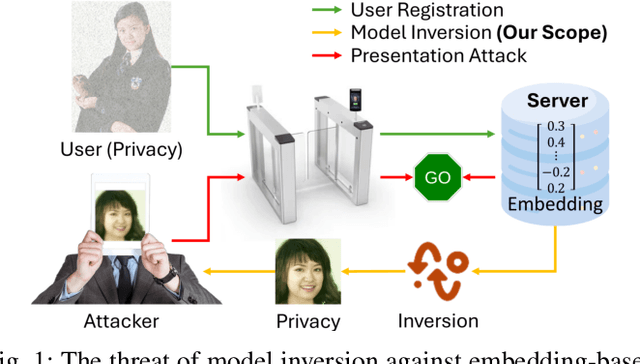

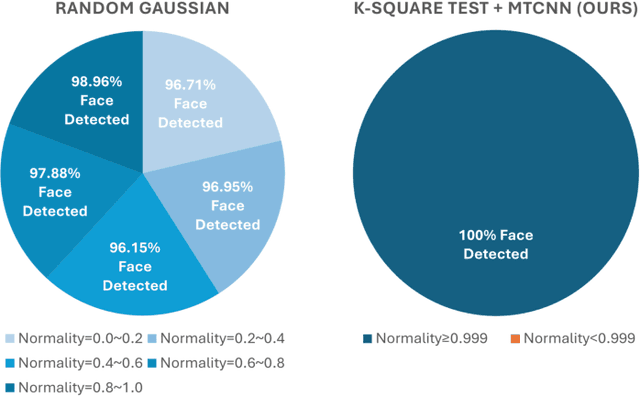
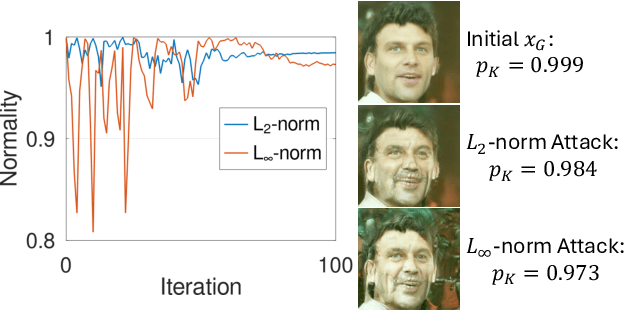
Facial recognition technology poses significant privacy risks, as it relies on biometric data that is inherently sensitive and immutable if compromised. To mitigate these concerns, face recognition systems convert raw images into embeddings, traditionally considered privacy-preserving. However, model inversion attacks pose a significant privacy threat by reconstructing these private facial images, making them a crucial tool for evaluating the privacy risks of face recognition systems. Existing methods usually require training individual generators for each target model, a computationally expensive process. In this paper, we propose DiffUMI, a training-free diffusion-driven universal model inversion attack for face recognition systems. DiffUMI is the first approach to apply a diffusion model for unconditional image generation in model inversion. Unlike other methods, DiffUMI is universal, eliminating the need for training target-specific generators. It operates within a fixed framework and pretrained diffusion model while seamlessly adapting to diverse target identities and models. DiffUMI breaches privacy-preserving face recognition systems with state-of-the-art success, demonstrating that an unconditional diffusion model, coupled with optimized adversarial search, enables efficient and high-fidelity facial reconstruction. Additionally, we introduce a novel application of out-of-domain detection (OODD), marking the first use of model inversion to distinguish non-face inputs from face inputs based solely on embeddings.
The Invisible Threat: Evaluating the Vulnerability of Cross-Spectral Face Recognition to Presentation Attacks
May 01, 2025Cross-spectral face recognition systems are designed to enhance the performance of facial recognition systems by enabling cross-modal matching under challenging operational conditions. A particularly relevant application is the matching of near-infrared (NIR) images to visible-spectrum (VIS) images, enabling the verification of individuals by comparing NIR facial captures acquired with VIS reference images. The use of NIR imaging offers several advantages, including greater robustness to illumination variations, better visibility through glasses and glare, and greater resistance to presentation attacks. Despite these claimed benefits, the robustness of NIR-based systems against presentation attacks has not been systematically studied in the literature. In this work, we conduct a comprehensive evaluation into the vulnerability of NIR-VIS cross-spectral face recognition systems to presentation attacks. Our empirical findings indicate that, although these systems exhibit a certain degree of reliability, they remain vulnerable to specific attacks, emphasizing the need for further research in this area.
Achieving 3D Attention via Triplet Squeeze and Excitation Block
May 09, 2025The emergence of ConvNeXt and its variants has reaffirmed the conceptual and structural suitability of CNN-based models for vision tasks, re-establishing them as key players in image classification in general, and in facial expression recognition (FER) in particular. In this paper, we propose a new set of models that build on these advancements by incorporating a new set of attention mechanisms that combines Triplet attention with Squeeze-and-Excitation (TripSE) in four different variants. We demonstrate the effectiveness of these variants by applying them to the ResNet18, DenseNet and ConvNext architectures to validate their versatility and impact. Our study shows that incorporating a TripSE block in these CNN models boosts their performances, particularly for the ConvNeXt architecture, indicating its utility. We evaluate the proposed mechanisms and associated models across four datasets, namely CIFAR100, ImageNet, FER2013 and AffectNet datasets, where ConvNext with TripSE achieves state-of-the-art results with an accuracy of \textbf{78.27\%} on the popular FER2013 dataset, a new feat for this dataset.
A Visual Self-attention Mechanism Facial Expression Recognition Network beyond Convnext
Apr 12, 2025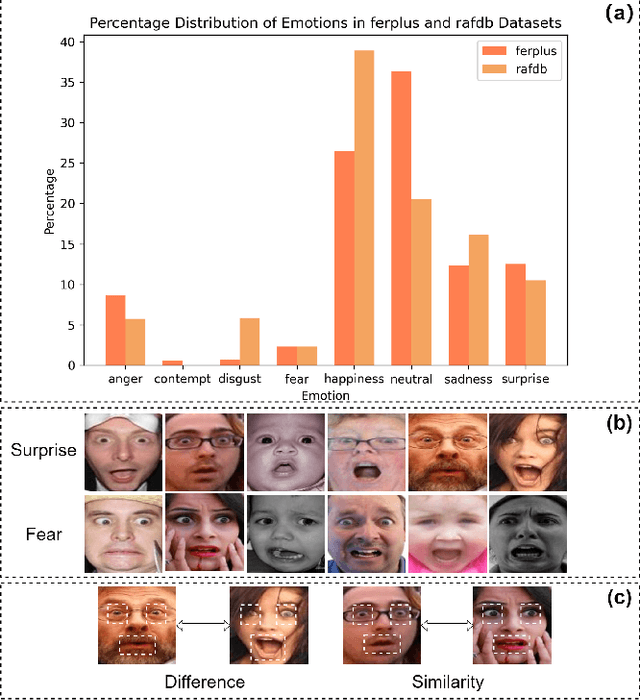
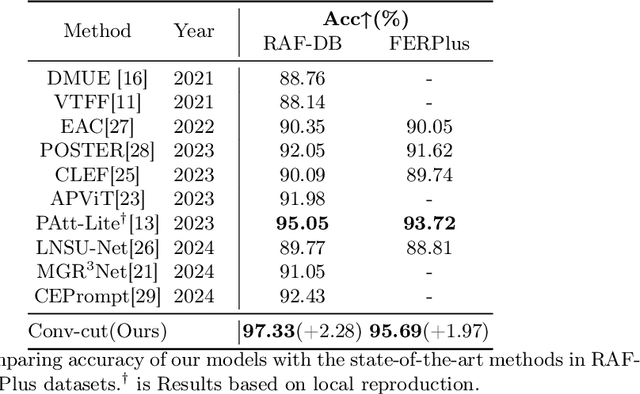
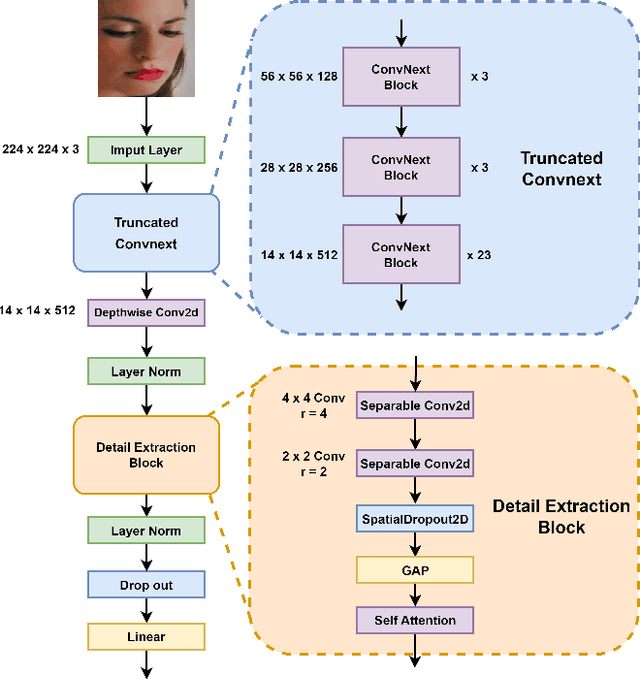

Facial expression recognition is an important research direction in the field of artificial intelligence. Although new breakthroughs have been made in recent years, the uneven distribution of datasets and the similarity between different categories of facial expressions, as well as the differences within the same category among different subjects, remain challenges. This paper proposes a visual facial expression signal feature processing network based on truncated ConvNeXt approach(Conv-cut), to improve the accuracy of FER under challenging conditions. The network uses a truncated ConvNeXt-Base as the feature extractor, and then we designed a Detail Extraction Block to extract detailed features, and introduced a Self-Attention mechanism to enable the network to learn the extracted features more effectively. To evaluate the proposed Conv-cut approach, we conducted experiments on the RAF-DB and FERPlus datasets, and the results show that our model has achieved state-of-the-art performance. Our code could be accessed at Github.
xTrace: A Facial Expressive Behaviour Analysis Tool for Continuous Affect Recognition
May 08, 2025Recognising expressive behaviours in face videos is a long-standing challenge in Affective Computing. Despite significant advancements in recent years, it still remains a challenge to build a robust and reliable system for naturalistic and in-the-wild facial expressive behaviour analysis in real time. This paper addresses two key challenges in building such a system: (1). The paucity of large-scale labelled facial affect video datasets with extensive coverage of the 2D emotion space, and (2). The difficulty of extracting facial video features that are discriminative, interpretable, robust, and computationally efficient. Toward addressing these challenges, we introduce xTrace, a robust tool for facial expressive behaviour analysis and predicting continuous values of dimensional emotions, namely valence and arousal, from in-the-wild face videos. To address challenge (1), our affect recognition model is trained on the largest facial affect video data set, containing ~450k videos that cover most emotion zones in the dimensional emotion space, making xTrace highly versatile in analysing a wide spectrum of naturalistic expressive behaviours. To address challenge (2), xTrace uses facial affect descriptors that are not only explainable, but can also achieve a high degree of accuracy and robustness with low computational complexity. The key components of xTrace are benchmarked against three existing tools: MediaPipe, OpenFace, and Augsburg Affect Toolbox. On an in-the-wild validation set composed of 50k videos, xTrace achieves 0.86 mean CCC and 0.13 mean absolute error values. We present a detailed error analysis of affect predictions from xTrace, illustrating (a). its ability to recognise emotions with high accuracy across most bins in the 2D emotion space, (b). its robustness to non-frontal head pose angles, and (c). a strong correlation between its uncertainty estimates and its accuracy.
Towards Large-Scale Pose-Invariant Face Recognition Using Face Defrontalization
Jun 04, 2025Face recognition under extreme head poses is a challenging task. Ideally, a face recognition system should perform well across different head poses, which is known as pose-invariant face recognition. To achieve pose invariance, current approaches rely on sophisticated methods, such as face frontalization and various facial feature extraction model architectures. However, these methods are somewhat impractical in real-life settings and are typically evaluated on small scientific datasets, such as Multi-PIE. In this work, we propose the inverse method of face frontalization, called face defrontalization, to augment the training dataset of facial feature extraction model. The method does not introduce any time overhead during the inference step. The method is composed of: 1) training an adapted face defrontalization FFWM model on a frontal-profile pairs dataset, which has been preprocessed using our proposed face alignment method; 2) training a ResNet-50 facial feature extraction model based on ArcFace loss on a raw and randomly defrontalized large-scale dataset, where defrontalization was performed with our previously trained face defrontalization model. Our method was compared with the existing approaches on four open-access datasets: LFW, AgeDB, CFP, and Multi-PIE. Defrontalization shows improved results compared to models without defrontalization, while the proposed adjustments show clear superiority over the state-of-the-art face frontalization FFWM method on three larger open-access datasets, but not on the small Multi-PIE dataset for extreme poses (75 and 90 degrees). The results suggest that at least some of the current methods may be overfitted to small datasets.
MMME: A Spontaneous Multi-Modal Micro-Expression Dataset Enabling Visual-Physiological Fusion
Jun 12, 2025Micro-expressions (MEs) are subtle, fleeting nonverbal cues that reveal an individual's genuine emotional state. Their analysis has attracted considerable interest due to its promising applications in fields such as healthcare, criminal investigation, and human-computer interaction. However, existing ME research is limited to single visual modality, overlooking the rich emotional information conveyed by other physiological modalities, resulting in ME recognition and spotting performance far below practical application needs. Therefore, exploring the cross-modal association mechanism between ME visual features and physiological signals (PS), and developing a multimodal fusion framework, represents a pivotal step toward advancing ME analysis. This study introduces a novel ME dataset, MMME, which, for the first time, enables synchronized collection of facial action signals (MEs), central nervous system signals (EEG), and peripheral PS (PPG, RSP, SKT, EDA, and ECG). By overcoming the constraints of existing ME corpora, MMME comprises 634 MEs, 2,841 macro-expressions (MaEs), and 2,890 trials of synchronized multimodal PS, establishing a robust foundation for investigating ME neural mechanisms and conducting multimodal fusion-based analyses. Extensive experiments validate the dataset's reliability and provide benchmarks for ME analysis, demonstrating that integrating MEs with PS significantly enhances recognition and spotting performance. To the best of our knowledge, MMME is the most comprehensive ME dataset to date in terms of modality diversity. It provides critical data support for exploring the neural mechanisms of MEs and uncovering the visual-physiological synergistic effects, driving a paradigm shift in ME research from single-modality visual analysis to multimodal fusion. The dataset will be publicly available upon acceptance of this paper.
Predicting Movie Production Years through Facial Recognition of Actors with Machine Learning
Apr 01, 2025This study used machine learning algorithms to identify actors and extract the age of actors from images taken randomly from movies. The use of images taken from Arab movies includes challenges such as non-uniform lighting, different and multiple poses for the actors and multiple elements with the actor or a group of actors. Additionally, the use of make-up, wigs, beards, and wearing different accessories and costumes made it difficult for the system to identify the personality of the same actor. The Arab Actors Dataset-AAD comprises 574 images sourced from various movies, encompassing both black and white as well as color compositions. The images depict complete scenes or fragments thereof. Multiple models were employed for feature extraction, and diverse machine learning algorithms were utilized during the classification and prediction stages to determine the most effective algorithm for handling such image types. The study demonstrated the effectiveness of the Logistic Regression model exhibited the best performance compared to other models in the training phase, as evidenced by its AUC, precision, CA and F1score values of 99%, 86%, 85.5% and 84.2% respectively. The findings of this study can be used to improve the precision and reliability of facial recognition technology for various uses as with movies search services, movie suggestion algorithms, and genre classification of movies.
Fragile Watermarking for Image Certification Using Deep Steganographic Embedding
Apr 18, 2025Modern identity verification systems increasingly rely on facial images embedded in biometric documents such as electronic passports. To ensure global interoperability and security, these images must comply with strict standards defined by the International Civil Aviation Organization (ICAO), which specify acquisition, quality, and format requirements. However, once issued, these images may undergo unintentional degradations (e.g., compression, resizing) or malicious manipulations (e.g., morphing) and deceive facial recognition systems. In this study, we explore fragile watermarking, based on deep steganographic embedding as a proactive mechanism to certify the authenticity of ICAO-compliant facial images. By embedding a hidden image within the official photo at the time of issuance, we establish an integrity marker that becomes sensitive to any post-issuance modification. We assess how a range of image manipulations affects the recovered hidden image and show that degradation artifacts can serve as robust forensic cues. Furthermore, we propose a classification framework that analyzes the revealed content to detect and categorize the type of manipulation applied. Our experiments demonstrate high detection accuracy, including cross-method scenarios with multiple deep steganography-based models. These findings support the viability of fragile watermarking via steganographic embedding as a valuable tool for biometric document integrity verification.
A Multimodal Framework for Explainable Evaluation of Soft Skills in Educational Environments
May 03, 2025



In the rapidly evolving educational landscape, the unbiased assessment of soft skills is a significant challenge, particularly in higher education. This paper presents a fuzzy logic approach that employs a Granular Linguistic Model of Phenomena integrated with multimodal analysis to evaluate soft skills in undergraduate students. By leveraging computational perceptions, this approach enables a structured breakdown of complex soft skill expressions, capturing nuanced behaviours with high granularity and addressing their inherent uncertainties, thereby enhancing interpretability and reliability. Experiments were conducted with undergraduate students using a developed tool that assesses soft skills such as decision-making, communication, and creativity. This tool identifies and quantifies subtle aspects of human interaction, such as facial expressions and gesture recognition. The findings reveal that the framework effectively consolidates multiple data inputs to produce meaningful and consistent assessments of soft skills, showing that integrating multiple modalities into the evaluation process significantly improves the quality of soft skills scores, making the assessment work transparent and understandable to educational stakeholders.
 Add to Chrome
Add to Chrome Add to Firefox
Add to Firefox Add to Edge
Add to Edge